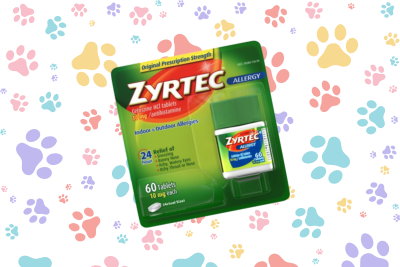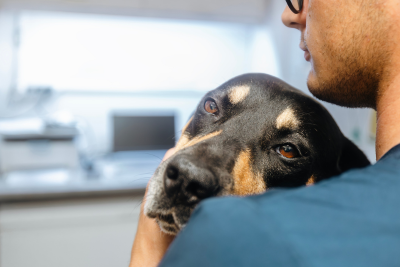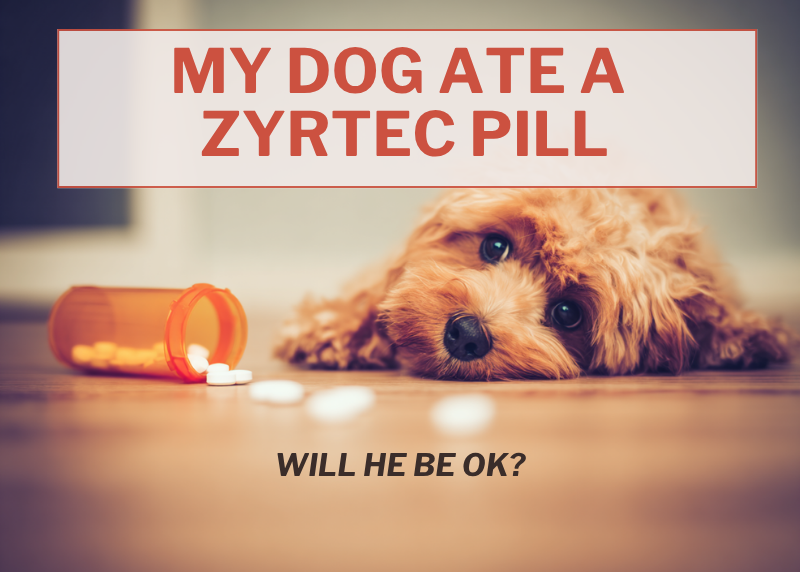My dog ate Zyrtec—should I freak out?” If that’s the frantic thought running through your head after your pup snatched a fallen pill off the floor, you’re not alone. Dogs are pros at eating things they shouldn’t, and allergy meds are no exception.
Zyrtec, commonly used to treat itchy skin, runny noses, and other mild allergy symptoms, is sometimes prescribed to dogs—but that doesn’t mean it’s always safe, especially when taken without a vet’s guidance. While one pill may not be a crisis, factors like your dog’s size, how much they ate, and even their heart rate afterward can help determine next steps.
In this post, we’ll walk you through exactly what to do if your dog eats a Zyrtec pill—what’s safe, what’s not, and when to pick up the phone and call your vet.
Looking for some Tips and tricks for living with animals when you’re allergic?
What Is Zyrtec, and Is It Safe for Dogs?

The brand name Zyrtec, contains cetirizine, which is its active ingredient, and is an over-the-counter antihistamine for dogs. Some vets prescribe it to treat dog allergy symptoms like sneezing, itchy skin, or watery eyes. While it was not originally developed as veterinary medicine, Zyrtec (cetirizine) is sometimes used off-label under a vet’s guidance. It’s considered one of the safer options for dog allergy medicine, especially because it’s typically non-drowsy compared to alternatives like Benadryl—though some dogs might still get a little sleepy.
Be Aware of Zyrtec-D
That said, just because Zyrtec is sold at the pharmacy doesn’t mean you should give it to your dog without vet-approved guidance. And it’s important to note that Zyrtec-D (which contains pseudoephedrine) is dangerous and should never be given to pets.
The biggest concern is Zyrtec-D, which contains pseudoephedrine, a stimulant that is highly toxic to dogs. It can cross the blood-brain barrier, leading to severe neurological symptoms like tremors, seizures, and even collapse. To be safe, only use single-ingredient tablets containing cetirizine—never Zyrtec-D, which includes pseudoephedrine and is highly toxic to dogs. If your dog accidentally ingests it, call your vet or poison control right away.
How Much Zyrtec Is Too Much?
If you’re wondering what the recommended dosage is for your specific dog so that they haven’t ingested too much of the allergy medication, make sure you know how much your dog weighs. The typical Zyrtec dosage for dogs is about 0.5 mg per pound of body weight. That means that 10 mg tablets might be fine for a 20-pound pup—but way too much for a 6-pound Chihuahua.
Let’s break it down:
- Small dogs (<10 lbs): Even one pill may be too much—call your vet.
- Medium dogs (10–50 lbs): One 10 mg pill may be tolerated, but monitor closely.
- Large dogs (50+ lbs): Usually tolerate one pill well, but symptoms should still be noted.
Even with proper dosing, it’s wise to monitor for any side effects of Zyrtec in dogs, such as drowsiness, restlessness, or upset stomach. When in doubt, dog owners should always check with their vet for the best treatment before assuming it’s safe for their furry friends as there could be harmful side effects if ingested too high of a dosage.
| Dog Size | Dosage | Breed Example |
|---|---|---|
| 5 lb. | 2.5 mg, or 1/2 of a 5 mg tablet | Chihuahua |
| 10 lb. | Up to 5 milligrams | Maltese |
| 30 lb. | Up to 15 milligrams | Cocker Spaniel |
| 50 lb. | Up to 20 milligrams | Siberian Husky |
| 100 lb. | Up to 20 milligrams | Great Pyrenees |
The number of pills and your dog’s health history also matter. When in doubt, call your vet.
? Dog ate Zyrtec and now you’re pricing out your couch for resale? Here’s how to save money as a dog parent.
Signs of a Problem: What to Watch For

If your dog shows no symptoms after eating one regular Zyrtec, you’re likely in the clear—but it’s good to know what to watch for:
Mild symptoms:
- Sleepiness or drowsiness
- Dry mouth
- Mild restlessness
Concerning symptoms:
- Vomiting or diarrhea
- Disorientation or hyperactivity
- Fast heart rate or tremors
If your dog consumed Zyrtec-D (contains pseudoephedrine), symptoms can appear within 30 minutes and escalate quickly, affecting the central nervous system and potentially leading to tremors, seizures, or even collapse. Take your dog to the emergency room right away.
What to Do Right Away
- Stay calm and determine exactly what your dog ate. Was it Zyrtec or Zyrtec-D? Look at the box or bottle if it’s available.
- Estimate how much your dog may have ingested and their weight.
- Call your veterinarian or the ASPCA Animal Poison Control Center at 888-426-4435 (a consultation fee may apply).
- Don’t induce vomiting unless a vet specifically instructs you to.
Most symptoms from Zyrtec appear within 30–90 minutes, so pet parents should keep an eye on their pup during that time. Dogs with pre-existing medical conditions or on other medications, can be more at risk for having an adverse reaction.
How to Prevent Accidental Ingestion
Accidents happen, but there are easy ways to prevent them:
- Keep all medications in a closed cabinet or drawer
- Avoid leaving pill bottles on counters, especially in reach of curious pups
- Use a locking pill organizer
Dogs sniff out and gobble up dropped pills because the scent or coating makes them seem like tasty treats—even when they are not.
FAQ: Common Questions About Dogs and Zyrtec

1. Can dogs safely take Zyrtec?Yes, but only under veterinary supervision. While Zyrtec (not Zyrtec-D) is prescribed for allergies, it’s important to confirm dosage and risks for your specific dog.
2. What happens if my dog eats a Zyrtec pill?Most likely, they’ll be okay—but you should monitor them closely and call your vet to be sure. Small dogs and multiple pills increase the risk of side effects.
3. What’s the difference between Zyrtec and Zyrtec-D?Zyrtec-D contains pseudoephedrine, which is highly toxic to dogs. If your dog ingests Zyrtec-D, it’s an emergency—call your vet or poison control immediately.
4. How do I know how much Zyrtec is too much for my dog?A general guideline is 0.5 mg per pound of body weight, but 20 mg is often the max safe dose. Always consult your vet.
5. What are signs my dog is reacting poorly to Zyrtec?Watch for vomiting, diarrhea, lethargy, disorientation, or tremors. If any symptoms appear, seek veterinary attention.
6. Do vets prescribe Zyrtec for atopic dermatitis in dogs? Yes, vets often prescribe Zyrtec as part of a treatment plan for atopic dermatitis. It helps relieve itching and inflammation, though it doesn’t work for every dog and is usually paired with other treatments.
7. Can large dogs handle Zyrtec better than small ones?Yes. Large dogs typically tolerate a 10 mg dose better than small or toy breeds, who may be more sensitive.
8. Do vets ever prescribe Zyrtec for dog allergies? Yes, veterinarians often prescribe Zyrtec to treat skin allergies, insect bites, itching, hot spots, runny nose, and other symptoms caused by environmental allergens
9. Can I give my dog the oral syrup version of Zyrtec? Only with caution. Some generic or children’s liquid versions may contain xylitol, which is toxic to dogs. Always check the label and ask your vet first.
10. What should I keep on hand in case of a medication emergency?Your vet’s number, ASPCA Poison Control’s number (888-426-4435), and a list of any medications your dog takes regularly.
A Pill, a Pup, and a Plan

If your dog ate a Zyrtec pill, don’t panic—but don’t ignore it either. A quick label check, a call to your vet, and some light monitoring might be all it takes to keep your pup safe and sound. When in doubt, it’s always better to ask. You know your pup best, and catching something early can make all the difference.

